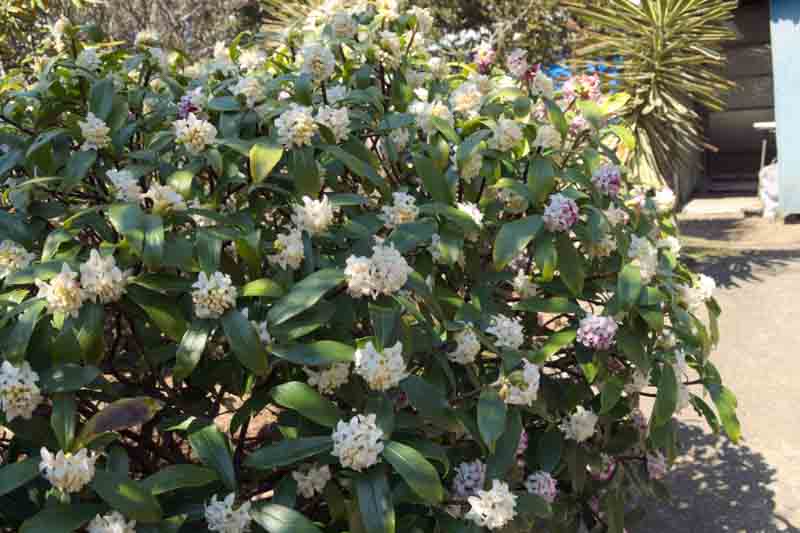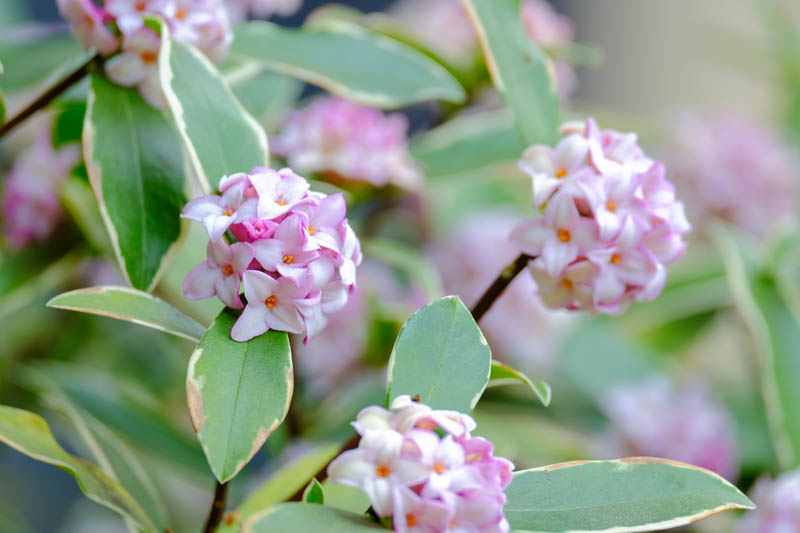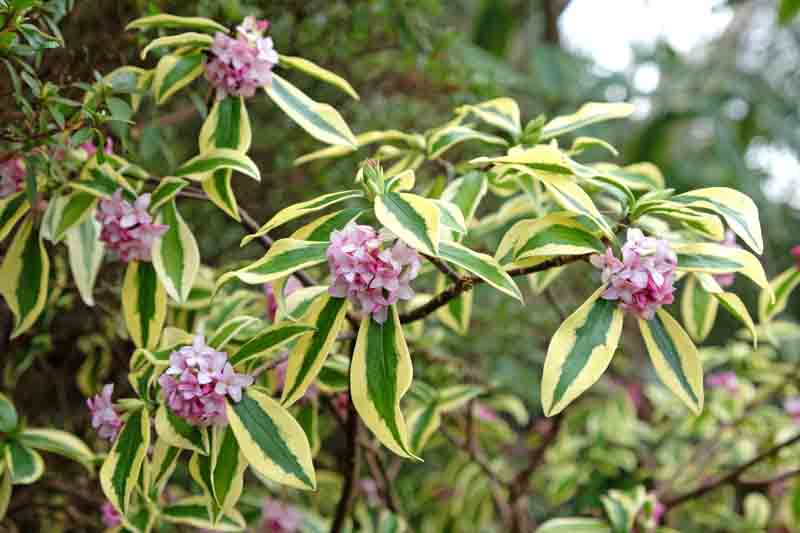Winter Daphne, Japan Daphne, Dwarf Bay, Fragrant Daphne, Paradise Plant, Spurge Flax, Spurge Laurel, Daphne japonica
Daphne odora’s unmatched fragrance and early bloom time make it a cherished addition to the garden, offering beauty and scent when most needed.
Daphne odora, commonly known as winter daphne, is a beloved evergreen shrub known for its fragrant, pale pink to white flowers and glossy, dark green leaves. It’s a plant that adds interest and fragrance to gardens during the late winter and early spring months when few other plants are in bloom.
Native: This plant is native to China, Japan and Korea, where it grows in woodland areas, bringing understory beauty and fragrance to these settings. Winter daphne belongs to the daphne family, Thymelaeaceae.
Plant Type and Habit: Winter daphne is an evergreen shrub with a rounded, bushy habit.
Size: Daphne odora generally grows 3 to 6 feet tall (90-180 cm) and 2 to 4 feet wide (60-120 cm), making it an ideal size for many garden settings.
Flowers: The flowers are its most notable feature, with clusters of star-shaped blooms that are highly fragrant. The flowers range from white to pale pink, often with a deeper pink blush outside. Winter daphne blooms in late winter to early spring, providing a much-needed splash of color and scent during a time when most of the garden is still dormant.
Fruits: Following flowering, it produces small, red berries that can add interest but are rarely the main attraction.
Foliage: The evergreen foliage is dark green, glossy, and leathery, providing year-round interest in the garden.
Hardiness: It is hardy in USDA zones 7 to 9, requiring protection in colder climates.
Uses: Daphne odora is perfect for use in shaded borders, woodland gardens, or as a specimen plant in a container where its fragrance can be enjoyed up close. It also thrives in a butterfly or winter garden.
Wildlife: Bees flock to its nectar and pollen, while butterflies, moths, and flies are drawn to the nectar of this fragrant winter-flowering shrub.
Deer and Rabbits: Deer and rabbits may be deterred by its toxicity, making it a good choice for gardens plagued by these visitors.
Salt Tolerance: Daphne is moderately salt-tolerant.
Toxicity: All parts of Daphne odora are toxic if ingested, and its sap can irritate the skin, so handle it with care.
Invasiveness: Daphne odora is not considered invasive. It grows slowly and remains compact.

Sunlight: Winter Daphne thrives in full sun to partial shade. A spot that receives morning sun and afternoon shade is ideal.
Soil: Prefers well-drained, fertile, slightly acidic to neutral soil. Good drainage is crucial to avoid root rot.
Timing: Plant in the fall or spring when the weather is cool.
Method: Dig a hole as deep and twice as wide as the root ball. Mix in compost or peat moss to improve drainage. Place the plant in the hole, ensuring the top of the root ball is level with the soil surface. Backfill gently and water thoroughly. Winter Daphne resents root disturbance and transplanting.

Daphne shrubs are easy to propagate from semi-hardwood cuttings.
Winter Daphne is a beautiful, fragrant shrub with no serious pest or disease issues. However, like all plants, it can be potentially affected by certain pests, diseases, and common problems.
Aphids: These small, sap-sucking insects can congregate on new growth, weakening the plant. A strong jet of water or insecticidal soap can help manage them.
Scale Insects: Scale can attach themselves to the stems and underside of leaves, sucking sap and weakening the plant. Horticultural oils or systemic insecticides can be effective treatments.
Root rot: Overwatering or poorly draining soil can lead to root rot, a serious condition that can kill the plant. Ensure good drainage and avoid overwatering.
Fungal Diseases: Leaf spot and other fungal issues can arise in damp conditions or if the plant is not in a well-ventilated space. Prune affected areas and consider fungicidal sprays if the problem persists.
Yellowing Leaves: Overwatering, poor drainage, or nutrient deficiencies can cause leaves to yellow. Adjust watering practices and ensure the soil is well-draining. A soil test can help identify if supplemental fertilization is needed.
Leaf Drop: Winter Daphne may drop leaves in response to stress, such as sudden temperature changes, drought, or transplant shock. Maintaining consistent care can help minimize stress.
Browning Leaves: Can be caused by too much sun, windburn, or frost damage. Planting in a sheltered location that receives partial shade can help prevent these issues.

Variegated Winter Daphne: Daphe odora ‘Mae Jima’
Winter Daphne (Daphne odora) prefers partial shade, especially in climates with hot summers. It thrives in a location that protects it from the harsh afternoon sun. Morning sun with afternoon shade or dappled sunlight throughout the day is ideal for promoting healthy growth and flowering.
Winter Daphne is renowned for its intoxicating fragrance, one of its most appealing features. The scent is rich, sweet, and somewhat citrusy, reminiscent of jasmine or orange blossom. This delightful fragrance makes it a popular choice for planting near walkways, entrances, or windows, where it can be enjoyed up close.
Yes, Winter Daphne is poisonous to dogs, as well as to cats and humans if ingested. All parts of the plant contain toxic substances that can cause symptoms such as drooling, vomiting, diarrhea, weakness, and in severe cases, convulsions or even coma. It’s important to plant Winter Daphne in areas away from pets and children or to educate those at risk about not ingesting any part of the plant.
The best place to plant Winter Daphne is in a location that meets its specific growing requirements:
| Hardiness |
7 - 9 |
|---|---|
| Heat Zones |
7 - 9 |
| Climate Zones | 4, 5, 6, 7, 8, 9, 10, 12, 14, 15, 16, 17, 18, 19, 20, 21, 22, 23, 24 |
| Plant Type | Shrubs |
| Plant Family | Thymelaeaceae |
| Exposure | Full Sun, Partial Sun |
| Season of Interest |
Spring (Early) Winter |
| Height |
3' - 6' (90cm - 180cm) |
| Spread |
2' - 4' (60cm - 120cm) |
| Spacing |
24" - 48" (60cm - 120cm) |
| Maintenance | Low |
| Water Needs | Average |
| Soil Type | Chalk, Clay, Loam, Sand |
| Soil pH | Acid, Neutral |
| Soil Drainage | Moist but Well-Drained, Well-Drained |
| Characteristics | Fragrant, Showy, Evergreen, Fruit & Berries |
| Tolerance | Salt |
| Attracts | Bees, Butterflies, Birds |
| Garden Uses | Beds And Borders, Patio And Containers, Small Gardens |
| Garden Styles | Informal and Cottage, City and Courtyard |
| Hardiness |
7 - 9 |
|---|---|
| Heat Zones |
7 - 9 |
| Climate Zones | 4, 5, 6, 7, 8, 9, 10, 12, 14, 15, 16, 17, 18, 19, 20, 21, 22, 23, 24 |
| Plant Type | Shrubs |
| Plant Family | Thymelaeaceae |
| Exposure | Full Sun, Partial Sun |
| Season of Interest |
Spring (Early) Winter |
| Height |
3' - 6' (90cm - 180cm) |
| Spread |
2' - 4' (60cm - 120cm) |
| Spacing |
24" - 48" (60cm - 120cm) |
| Maintenance | Low |
| Water Needs | Average |
| Soil Type | Chalk, Clay, Loam, Sand |
| Soil pH | Acid, Neutral |
| Soil Drainage | Moist but Well-Drained, Well-Drained |
| Characteristics | Fragrant, Showy, Evergreen, Fruit & Berries |
| Tolerance | Salt |
| Attracts | Bees, Butterflies, Birds |
| Garden Uses | Beds And Borders, Patio And Containers, Small Gardens |
| Garden Styles | Informal and Cottage, City and Courtyard |
How many Daphne odora (Winter Daphne) do I need for my garden?
| Plant | Quantity | |
|---|---|---|
| Daphne odora (Winter Daphne) | N/A | Buy Plants |
Create a membership account to save your garden designs and to view them on any device.
Becoming a contributing member of Gardenia is easy and can be done in just a few minutes. If you provide us with your name, email address and the payment of a modest $25 annual membership fee, you will become a full member, enabling you to design and save up to 25 of your garden design ideas.
Join now and start creating your dream garden!
Create a membership account to save your garden designs and to view them on any device.
Becoming a contributing member of Gardenia is easy and can be done in just a few minutes. If you provide us with your name, email address and the payment of a modest $25 annual membership fee, you will become a full member, enabling you to design and save up to 25 of your garden design ideas.
Join now and start creating your dream garden!